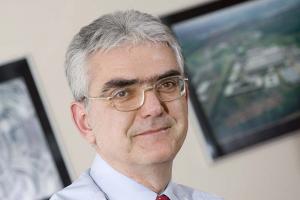Fusion electricity production in practical terms
20 Nov 2013
-
Sabina Griffith
In a few weeks, on 31 December 2013, the European Fusion Development Agreement known as EFDA will come to an end. It will be reborn as a consortium called EUROfusion. ITER Newsline talked to EFDA/JET leader Francesco Romanelli about the reasons for the reorganization and the implications for the European fusion landscape.
The new EUROfusion consortium will have a project-oriented approach, supporting roadmap missions, research in basic plasma processes and the preparation of the new ITER generation of scientists. Francesco Romanelli (photo: EFDA)
Can you share with us the reasons for the reorganization of the fusion landscape in Europe?
The main reason for this step is to adapt to the challenges of the ITER era. The transition is somewhat similar to what happened within the EURATOM program in the early 1970s when it was discovered that the T3 Tokamak in Russia was producing a temperature of 1keV — a major breakthrough at that time. The decision taken then by the fusion community, the European Commission and the heads of the laboratories was to streamline the European fusion program along the tokamak line and to go for a large common facility in Europe.
That was the time when the design of the JET facility was kicked off. We are now in a somewhat similar phase. We need to cope with the fact that, ten years from now, ITER will be in operation and we will then have to proceed rapidly on the preparation of a demonstration fusion power plant.
It sounds like the new consortium is more focused on delivering electricity?
The roadmap was developed by EFDA following the recommendations of a panel set up by the Director General of the European Directorate-General for Research and chaired by Albrecht Wagner. The Panel examined the strategic orientation of fusion research including the role of JET in support of ITER. Its main recommendation is to substantially restructure the European fusion program in order to cope with the challenges coming up with the start of ITER.
So what does that mean precisely? What will change?
What will change is that there will no longer be baseline support for the labs. We are setting up the program around a number of work packages that involve either the exploitation of major devices in a campaign-oriented approach—as we did and as we will continue to do with JET—or specific projects that reflect the roadmap mission.
I expect that this system will give to all the present EFDA members the possibility of participating to the activities of the system taking advantage of each laboratory's expertise. In addition to this, the consortium is going to support activities on what we call "enabling research" in order to support the basic understanding of the plasma processes. We are also willing to invest a substantial amount of resources on preparing the new ITER generation of scientists on the undergraduate, PhD and postdoctoral level.
We are now finalizing all open issues with the goal of implementing the roadmap on 1 January 2014. So, to summarize, we are about to put fusion electricity production into very practical terms.


